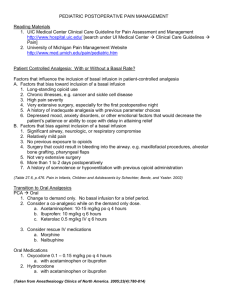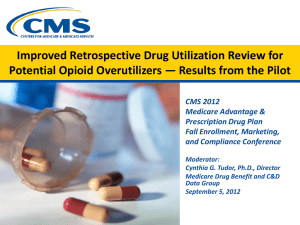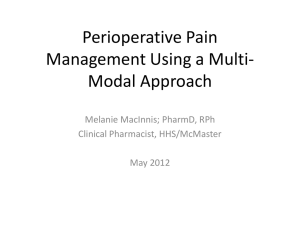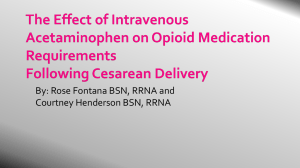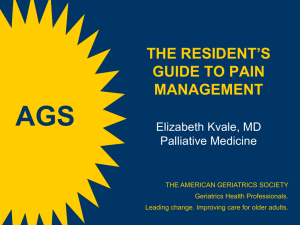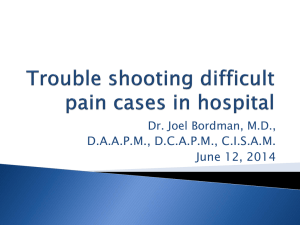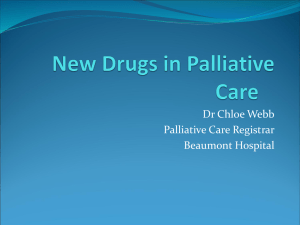Pain management in LTC - Virginia Medial Director`s Association
advertisement
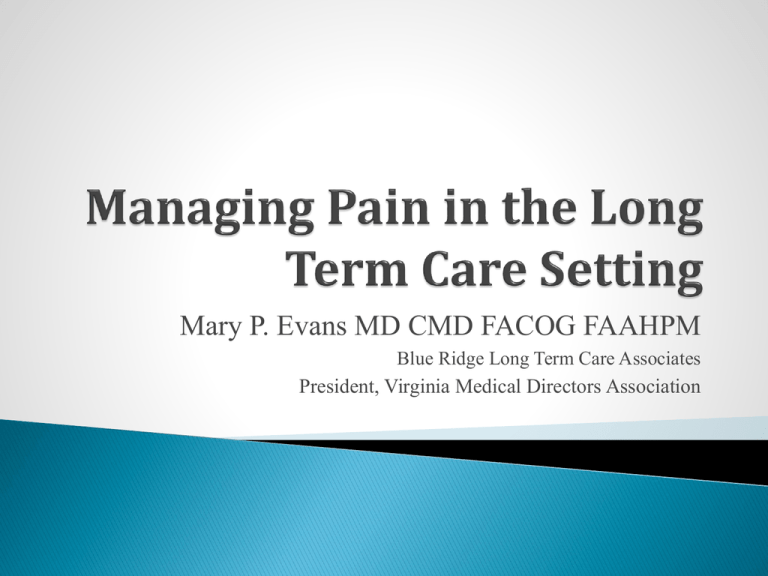
Mary P. Evans MD CMD FACOG FAAHPM Blue Ridge Long Term Care Associates President, Virginia Medical Directors Association Discuss the most common pain syndromes in the LTC population Describe several classes of pain medications and their indications Understand non-pharmacologic approaches to pain management and their use in LTC Describe appropriate pain regimen options for the LTC population 45-80% of residents in nursing facilities have chronic pain 51% of residents who report intermittent pain have pain every day Of these patients, 84% had order for prn pain meds, but only 15% of patients received prn med Nationally, LTC facilities are doing poorly on pain quality measures Ferrell et al, Pain in the Nursing Home, JAGS 1990;38:409-414 Back pain Arthritis Previous fx Neuropathy Leg cramps Foot pain Claudication Headache Generalized Cancer 40% 29% 14% 11% 9% 8% 8% 6% 3% 3% Stein et al, Pain in the Nursing Home. Clin Geriatr Med 1996;12:601-613 Incident pain Acute pain Chronic pain Musculoskeletal pain Bone pain Visceral pain Neuropathic pain Malignancy pain Psychosocial pain/existential pain Physical pain: medical conditions Emotional pain: anger, depression, anxiety Social pain: loneliness, family issues, financial issues Spiritual pain: life’s meaning, leaving a legacy, hopelessness, abandonment *Think of these concepts with patients who have pain that is difficult to control Unrecognized pain Difficulty communicating needs Lack of assessing for pain Unavailability of pain med order Pain med not available Narcotic script issues Cultural barriers and beliefs Personal opinions and beliefs Family interactions Physician attitudes, beliefs, biases, skills Use of pain medication: Physical dependence on pain medication – normal state of adaptation to ongoing pain med use Addiction to pain medication – psychological dependency Pseudoaddiction to pain medication – apparent drugseeking or asking for increased dosage when pain is undertreated Tolerance to pain medication – may need increased dose due to lessened effect or disease progression Chronicity: Acute, chronic, constant, intermittent Onset timing: Incidental, procedural, breakthrough, disturbance Quality, intensity Alleviating factors Exacerbating factors Associated symptoms, radiation of pain How it affects the patient: what is the patient no longer able to do as a result of the pain? What does this pain mean to the patient? What has been tried before to help the pain? Which pain medications have been tried? Were they helpful? Which medication, dose, timing seems to work best? Any difficulties taking oral meds? Pain is likely under-recognized, under-treated Communication difficulty Assessment difficulty Non-verbal pain assessment scales: ◦ ◦ ◦ ◦ FACES pain scale FLACC scale (face, legs, arms, consolability, cry) Discomfort scale PAINAD scale Facial expression- grimacing, frown, grinding teeth Posture – guarding, bracing, defensive posture Movement – rocking, rubbing, fidgeting, restlessness Behaviors – agitation, physical aggression, resisting cares, yelling out Vocalization - crying, groaning, whining, sighing Activities – ADL function, participation, gait Occurs with particular activities Getting out of bed Taking a shower Transferring to chair Anticipate the pain Oral pain med 30-60 min prior to procedure Premedicate before procedures: ◦ Dressing changes for wounds ◦ Moving patient for shower ◦ Transfer to hospital for procedure By mouth – oral or sublingual, avoid injections By the clock – schedule routinely, appropriate interval By the ladder – Step 1 – Acetaminophen (limit dosage), NSAID Step 2 – Opioid or combination Acetaminophen/Opioid Step 3 – Pure opioid, addition of adjuvant By the individual – can add adjuvants at any step; can start at higher step to relieve pain initially; quality of life; comorbidities, family support Morphine PO Morphine SC or IV Oxycodone PO Hydrocodone PO Hydromorphone PO Hydromorphone SC or IV Transdermal Fentanyl patch 30 mg 10 mg (1/3 dose) 20-30 mg 30 mg 7.5 mg (1/4 dose) 1.5 mg 12 mcg-25 mcg Muscles, ligaments, tendons, bones, nerves, joints Sprains, strains, overuse syndromes Bruises, bumps Inflammation, infection Loss of blood flow to muscle Low back pain in the most common chronic musculoskeletal pain Aching, stiffness “pulled muscle” feeling Fatigue, disrupts sleep Acetaminophen Acetaminophen/narcotic combo Pure opioid Corticosteroid Muscle spasms: ◦ ◦ ◦ ◦ ◦ ◦ ◦ ◦ Cyclobenzaprine Orphenadrine Metaxalone Methocarbamol Carisoprodol Tizanidine Baclofen Benzodiazepines PT/OT Splint for immobilization, rest Mobilization Heat, cold Relaxation, biofeedback Stretching exercises Therapeutic massage Described as aching, dull, deep, boring, constant, may be weather-dependent Difficult to localize Present at rest and with movement Somatic pain Fractures Healed fracture DJD Metastasis to bone (breast, lung, prostate) Sickle cell disease Myeloma Paget’s disease Corticosteroids Calcitonin Bisphosphonates (*GI symptoms, keep upright) Palliative radiotherapy Nonsteroidal anti-inflammatory drugs Narcotic pain meds Distension of hollow organ Stretching of smooth muscle Stomach Small and large intestines Gall bladder Kidney/ureter Crampy, intermittent pain May be difficult to localize Can be mild to severe History is important – especially timing of pain Evacuation of the distended hollow viscus Relief of constipation, disimpaction Surgical treatment Prevent future episodes Bowel obstruction: ◦ Octreotide ($$$$) ◦ Anticholinergics: hyoscine, scopolamine, glycopyrrolate ($) ◦ Corticosteroids ($) ◦ especially end of life care Appendicitis Early inflammation – crampy abdominal pain, nausea and vomiting ◦ Patient is uncomfortable, writhing on table ◦ Visceral pain, difficult to localize Later in course – localization of pain to right lower quadrant, fever, malaise, leukocytosis ◦ Patient lies still, + rebound Compression of nerve Post-entrapment nerve injury Regional pain syndromes Skeletal muscle spasms Post-herpetic neuralgia Acetaminophen Acetaminophen/narcotic combo Pure opioid Add adjuvant meds, therapies early on Administered by therapist Transcutaneous electrical nerve stimulation Battery-operated, portable units Electrical current disrupts pain signal Questionable validity (Cochrane Collaboration, 2008) Heat, cold application Muscle massage, stretching, ROM Ultrasound, TENS Acupuncture, acupressure Physical and occupational therapy Positioning, devices, pillows, chairs Meditation, relaxation Spiritual counseling and prayer Hypnosis, biofeedback Aromatherapy, herbal therapy Music and sound therapy Art therapy E-stim Diathermy Laser therapy Heat/cold application Topical treatments – menthol, capsaicin First documented use in ancient Rome, AD 63 Scribonius Largus described pain relief by standing on an electrical fish at the seashore 16th-18th century – electrostatic devices for headaches and pain Benjamin Franklin was a proponent of electrical stimulation treatment of pain Administered by therapist Electrical current causes contraction of muscle or muscle group Helps strengthen affected muscle Promotes blood supply to area – promotes healing Active component of chili peppers Ointment, spray, cream forms Minor aches, pains, DJD, strains and sprains Post-herpetic neuralgia Neurons are depleted of neurotransmitter (substance P), fatigues nerves “Start low, go slow” Don’t forget the bowel regimen Constipation – add stool softener, stimulant right away Nausea, vomiting – often transient for 3-4 days Sedation – no driving, methylphenidate, caffeine Delerium – lorazepam Pruritis – usually dissipates; antihistamine Urinary retention – monitor output, comfort Myoclonic jerks – metabolite buildup; lower dose or consider rotating to a different opioid Respiratory depression – uncommon except when starting fentanyl patch in opioid-naïve patient Hospice, end of life care Multiple drug allergies Route of administration alternatives: ◦ Transdermal fentanyl ◦ Oral meds administered rectally ◦ Avoid injectable meds if possible Addition of antidepressants ◦ ◦ ◦ ◦ TCA’s: Amitriptyline, nortriptyline* SSRI‘s: paroxetine, citalopram NSRI: venlafaxine* Other: bupropion * watch for anticholinergic symptoms Addition of neuroleptics: ◦ ◦ ◦ ◦ ◦ ◦ ◦ ◦ Gabapentin Topiramate Lamotrigine Carbamazepine Levetiracetam Pregabalin Phenytoin Valproic Acid NMDA antagonists: ◦ ◦ ◦ ◦ Ketamine Dextromethorphan Memantine Amantadine Local Anesthetics: ◦ Lidocaine – gel, patch ◦ Mexiletine Other: ◦ ◦ ◦ ◦ Baclofen Cannabinoids Methylphenidate Capsaicin Alpha-adrenergic agonists: clonidine, tizanidine Corticosteroids: ◦ Dexamethasone (intracranial pressure) ◦ Prednisone (DJD, bone pain) Pain despite escalating doses Consider possibility of drug diversion Consider existential/psychosocial pain Chronic pain – may try rotating to another opioid “Opioid fatigue”, tolerance Remember to reduce calculated conversion dose by 50% for cross-tolerance Post-op patients: ◦ ◦ ◦ ◦ Schedule pain meds x 7 days prn pain meds available Treat pain aggressively until comfortable Remember the bowel regimen! Patients with dementia, behaviors: Difficulty asking for meds, communicating Schedule acetaminophen tid-qid Have opioid available for pain not relieved by acetaminophen Consider lidocaine patch Consider scheduled opioid for daily moderate to severe pain (bowel regimen!) Hospice, end of life care: Have liquid morphine, liquid lorazepam available Rectal acetaminophen Can also administer oral meds via rectal route Transdermal fentanyl patch (appropriate dose) if unable to swallow (not in opioid naïve patients) Long-acting opioids once optimal 24h dose achieved Acyclic analog of morphine, heroin NMDA receptors – neuropathic pain Used in hospice, end of life care Long half-life, long-acting Strong analgesic Cheap ($) Chronic pain use – anti-addictive Less sedative than other opioids Many metabolites Liability risk (?) Variable metabolism/half-life in the elderly Use cautiously in select patients Approved in the US for detoxification treatment of opioid addiction Must follow strict federal regulations in detox programs Programs must be certified by Federal Substance Abuse and Mental Health Services Administration Programs must be registered with the Drug Enforcement Agency (DEA)

